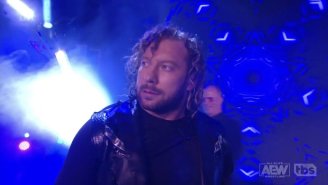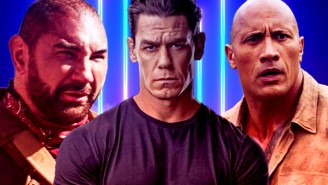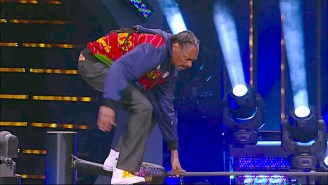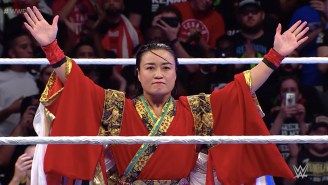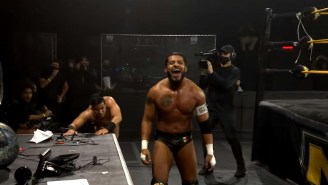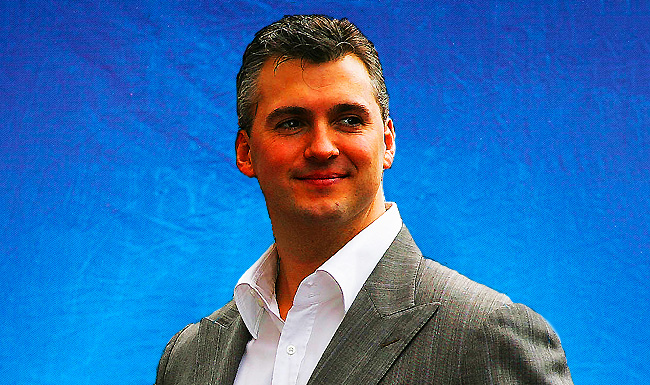
Shane McMahon is back. After several years away, the no-longer-so-boyish Boy Wonder returned on Raw, and the response from the WWE Universe surprised pretty much everybody, including Shane. The return of the 40-something-year-old son of the boss being the hottest event along this year’s road to WrestleMania may sound slightly absurd, but Shane has always occupied a special place in fans’ hearts. Whether he’s taking 50-foot leaps off the Titantron or defiantly walking out on the family business, Shane has always done things a bit differently than the rest of the McMahon clan, both in front of and behind the cameras.
Put on your baggiest sports jersey, because here comes the facts Shane-O-Fans need to know…
Shane was beat up on and stuffed into lockers by wrestlers as a kid.
Posing for pictures like this might have contributed to the hazing.
On January 15, 1970, Shane Brandon McMahon was born in Gaithersburg, Maryland, the town Vince and Linda McMahon had set up in while promoting WWWF events in Washington, D.C. for Vince’s father.
As you might expect, Shane was immediately enamored with the cartoonish, living action figure world of professional wrestling, and hoped he could become André the Giant’s tag team partner someday if he ate enough. Little kids are dumb, okay? As Shane got older, he started hanging around backstage and claims he became something of a “backstage mascot” for the wrestlers. According to Shane, the old-timers like Ivan Putski would stretch him, throw him in lockers and just generally kick the crap out of him. Hmm, that doesn’t necessarily match my definition of a mascot, but I guess you have to tell the boss’ son something to make him feel better as you’re stuffing his skinny ass in a broom closet.
His first on-screen role was as a referee named “Shane Stevens.”
https://youtu.be/94o_ubkOhJ4?t=30s
Most fans first got to know Shane McMahon when he allied with his father to form The Corporation in the late ’90s, but he was actually a regular on WWF TV as early as 1989, doing a couple-year stint as just another bow tie-wearing referee named “Shane Stevens.” Shane didn’t exactly stand out during this period, a good ref isn’t supposed to, but he pops up in the background during some pretty major matches, including Randy Savage’s WrestleMania VIII match with Ric Flair, and the 1991 Royal Rumble.
Shane was notorious for partying with the talent in the ’80s and ’90s.
Uncle Johnny wants YOU to pick up the tab.
Shane may not have made much of an impact in the late ’80s/early ’90s, but he excelled in other keys areas, namely getting trashed with the talent. According to Raven, who had a run in the WWF as manager Johnny Polo in the early ’90s, he used to get in trouble all the time for keeping Shane out all night drinking, carousing and, well, doing all the other very non-PG things Raven does at three in the morning. As I covered previously, Bret Hart also had a violent run-in with the boss’ son after a drunk and rowdy Shane grabbed his wife’s ass. Hey, Shane always wanted the boys to respect him, and back then, partying ability was more important than mat skills.
He was the original commentator for Sunday Night Heat.
Proof WWE’s commentary situation has never made any sense.
Shane also had another on-air role before becoming a full-on WWF character. In August, 1998, Shane became the inaugural color commentator for Sunday Night Heat, announcing alongside guys like Jerry Lawler, Jim Cornette and Kevin Kelly. Shane even got to step up and announce an episode of Monday Night Raw. It was a logical career move – Vince McMahon had spent years as a color commentator before moving up the corporate ladder. Thankfully, Shane, who was every bit as mediocre behind the announcer’s table as his daddy, only stuck to the gig for a few months, rather than torturing fans for more than 25 years.
Shane wanted to run ECW and WCW as independent companies.
Shane spent most of the ’80s and ’90s dabbling in various aspects of the wrestling business, with the expectation that he would, someday, take over the business from his father like his father and grandfather had before him. Unfortunately for Shane, as the ’90s rolled to a close, it became apparent that his little sister Stephanie and her husband Triple H were the power couple on the rise and new heir apparents. Muscled out of a meaningful leadership position, Shane became fixated on breaking free of the WWF and running his own independent wrestling organization.
In 2000, Shane suggested Vince buy the slowly dying ECW and let him run it as a separate promotion. Vince instead opted to let the promotion die, then buy its name and tape library at fire sale prices. Later in 2006 when WWE revived ECW, Shane pitched that it should be made as independent of WWE as possible, with him as the figurehead. Vince again rejected Shane’s ideas, making ECW a watered-down third WWE brand.
Shane’s storyline purchasing of WCW was also supposed to have much more of a real edge to it. Shane was set to run a legitimate WCW division and be the public face of a separate WCW TV show, but of course, WCW was instead quickly killed off in the ill-fated Invasion storyline. Yup, Vince just really seemed to hate the idea of a family member setting up a semi-independent alternative to WWE – or at least he did until he let Triple H do it with NXT. You start to see why Shane had to take a little WWE breather.
He also tried to convince his dad to buy UFC.
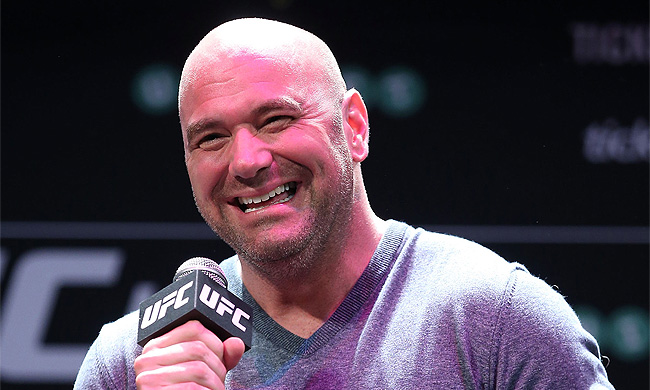
Here comes the real money.
Shane didn’t just pester his dad to buy him wrestling promotions to play with, he also pushed the idea of snatching up UFC back in the early 2000s when WWE could have bought the company for a song. Considering UFC is now worth about $3.5 billion, WWE won’t be getting that chance again any time soon. Whoops!
Later in 2006, Shane also tried to get Vince to crack open his dusty wallet and buy PRIDE. This plan got further than most, with WWE.com even reporting on meetings between WWE and the Japanese MMA organization, but it fell through at the last minute. Mere months later, UFC swooped in and bought PRIDE, taking a little bit more of Shane’s pride with them.
A mix-up led to Shane being thrown through real glass in his infamous street fight with Kurt Angle.
Ultimately, what Shane McMahon will probably be best remembered for are the death-defying stunts he used to regularly insert into his matches. Of course, most of the time, Shane’s life was actually relatively unthreatened – sure, it looked cool as hell when Steve Blackman knocked him off the Titantron, but he fell in a very safe way onto a big-ass crash pad.
That said, there was one instance where Shane was put in legit danger. During his street fight with Kurt Angle at the 2001 King of the Ring, Shane gets his ass violently thrown through two panes of glass. The first time Kurt goes to suplex Shane through the glass, it doesn’t even break, causing Shane to fall in a heap on his head in a moment I’m still cringing from 15 years later. At the time, something felt off about the whole thing, and it turns out the brutality of glass spots was due to a potentially serious production mistake.
The glass Angle threw Shane through was supposed to be sugar glass, which looks like the real thing, but shatters easily and doesn’t cut skin. Well, somehow the crew forgot to install the sugar glass, using good, sturdy, flesh-ripping plexiglass instead. Both Shane and Angle ended up torn up by the glass, and Shane almost certainly ended up with a concussion, but they did get one of the most memorable spots in pro wrestling history out of the deal.
He was responsible for launching WWE.com and expanding the company worldwide.
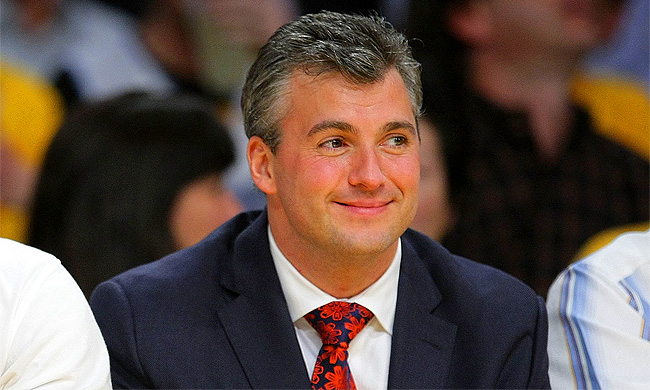
Vice President of knowing about the Internet and countries other than America.
Shane may have been forced to take a back seat to Stephanie and Triple H, but he continued to quietly make a big impact on WWE business behind the scenes. As head of WWE’s Digital Media department, Shane launched WWE.com in 1998 and nurtured its growth, turning the site into a major cornerstone of WWE’s business. Eventually, Shane moved on to become Vice President of Global Media and negotiated major WWE TV deals in England, Mexico, South America and other spots around the globe. For much of the 2000s, with the popularity of the WWE TV product stagnant in America, it was these international agreements that kept the company growing. Dolla dollas, indeed.
Shane has a clever cameo in the 2002 Rollerball remake.
Shane McMahon’s sole acting credit is a cameo in the 2002 remake of Rollerball. Shane briefly pops up for a reaction shot during a gathering of Rollerball promoters, which may seem kind of pointless, but it’s actually one of the few clever moments in an otherwise DOA movie. Rollerball is compared to wrestling numerous times in the movie, and even openly called sports entertainment, so the implication is Shane carried on the family business and is still fleecing the rubes in the dystopian future. Also, yes, the only place Shane McMahon will ever get to run WWE is a 2002 LL Cool J movie with a 3% on Rotten Tomatoes. Youch.
He was CEO of the biggest pay-per-view service in China.
In late 2009, Shane McMahon shocked the wrestling world by resigning from WWE. He didn’t give much of a reason at the time, but if you’ve read this far, it should be pretty clear what drove him out.
For most wrestling fans, it was out of sight, out of mind, but Shane has been keeping busy since his departure. Shane became the CEO of YOU On Demand, the biggest video-on-demand and pay-per-view provider in China. That’s a pretty impressive title, although YOU On Demand never actually turned a profit during the years Shane was CEO, despite having a country of 1.3 billion people to themselves. Maybe there’s a reason Shane is taking a break from business to jump off cages again.
There you are, a few facts from the mean streets of Greenwich, Connecticut. Know any interesting tidbits I missed? Just want to share some favorite Shane-O-Memories? Dance on down to the comments, below.
via Wrestling Observer, Sportskeeda, Talk is Jericho, What Culture, Wrestling Inc. & Buzzfeed

